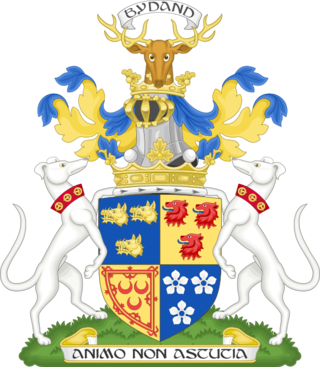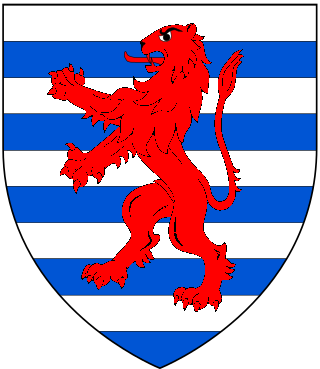Related Research Articles

Marquess of Aberdeen and Temair, in the County of Aberdeen, in the County of Meath and in the County of Argyll, is a title in the Peerage of the United Kingdom. It was created on 4 January 1916 for John Hamilton-Gordon, 7th Earl of Aberdeen.

Earl of Longford is a title that has been created twice in the Peerage of Ireland.

Marquess of Huntly is a title in the Peerage of Scotland that was created on 17 April 1599 for George Gordon, 6th Earl of Huntly. It is the oldest existing marquessate in Scotland, and the second-oldest in the British Isles; only the English marquessate of Winchester is older. The Marquess holds the following subsidiary titles: Lord Gordon of Strathaven and Glenlivet and Earl of Aboyne, and Baron Meldrum, of Morven in the County of Aberdeen.
The Peerage of the United Kingdom is one of the five Peerages in the United Kingdom. It comprises most peerages created in the United Kingdom of Great Britain and Ireland after the Acts of Union in 1801, when it replaced the Peerage of Great Britain. New peers continued to be created in the Peerage of Ireland until 1898

Earl of Suffolk is a title which has been created four times in the Peerage of England. The first creation, in tandem with the creation of the title of Earl of Norfolk, came before 1069 in favour of Ralph the Staller; but the title was forfeited by his heir, Ralph de Guader, in 1074. The second creation came in 1337 in favour of Robert de Ufford; the title became extinct on the death of his son, the second Earl, in 1382. The third creation came in 1385 in favour of Michael de la Pole. The fourth creation was in 1603 for Lord Thomas Howard, the second son of Thomas Howard, 4th Duke of Norfolk, by his second wife Margaret Audley, the daughter and eventual sole heiress of Thomas Audley, 1st Baron Audley of Walden, of Audley End in the parish of Saffron Walden in Essex. Howard was a prominent naval commander and politician and served as Earl Marshal, as Lord Chamberlain of the Household and as Lord High Treasurer. In 1597 he was summoned to Parliament as Baron Howard de Walden, and in 1603 he was further honoured, at the start of the reign of King James I, when he was created Earl of Suffolk. His second son the Hon. Thomas Howard was created Earl of Berkshire in 1626.

Earl of Haddington is a title in the Peerage of Scotland. It was created in 1627 for the noted Scottish lawyer and judge Thomas Hamilton, 1st Earl of Melrose. He was Lord President of the Court of Session from 1616 to 1625. Hamilton had already been created Lord Binning in 1613 and Lord Binning and Byres, in the County of Haddington, and Earl of Melrose, in the County of Roxburgh, in 1619. These titles were also in the Peerage of Scotland. The title of the earldom derived from the fact that he was in possession of much of the lands of the former Melrose Abbey. However, Hamilton was unhappy with this title and wished to replace it with "Haddington". In 1627 he relinquished the earldom of Melrose and was instead created Earl of Haddington, with the precedence of 1619 and with limitation to his heirs male bearing the surname of Hamilton. This derived from the fact that he considered it a greater honour to take his title from a county rather than from an abbey. Hamilton was a member of the prominent Scottish family of that name and descended from John de Hamilton, younger son of Walter de Hamilton, who was granted the feudal barony of Cadzow and who is also the ancestor of the Dukes of Hamilton and Dukes of Abercorn.

Earl of Kingston is a title in the Peerage of Ireland. It was created in 1768 for Edward King, 1st Viscount Kingston. The Earl holds the subsidiary titles Baron Kingston, of Rockingham in the County of Roscommon, Viscount Kingston, of Kingsborough in the County of Sligo, Baron Erris, of Boyle in the County of Roscommon, and Viscount Lorton, of Boyle in the County of Roscommon, also in the Peerage of Ireland. He is also a baronet in the Baronetage of Ireland. Between 1821 and 1869 the earls also held the title Baron Kingston, of Mitchelstown in the County of Cork, in the Peerage of the United Kingdom.

Earl of Limerick is a title that has been created twice in the Peerage of Ireland, associated first with the Dongan family, then with the Pery family. It should not be confused with the title Viscount of the City of Limerick held by the Hamilton family also Earls of Clanbrassil.
Earl of Clancarty is a title that has been created twice in the Peerage of Ireland.

Earl Annesley, of Castlewellan in the County of Down, is a title in the Peerage of Ireland. It was created on 17 August 1789 for Francis Annesley, 2nd Viscount Glerawly, with special remainder to his younger brother the Honourable Richard Annesley. He had previously represented Downpatrick in the Irish House of Commons. The titles of Baron Annesley, of Castlewellan in the County of Down, and Viscount Glerawly, in the County of Fermanagh, were created in the Peerage of Ireland on 20 September 1758 and 14 November 1766 respectively for his father William Annesley, who sat as Member of the Irish Parliament for Midleton. Annesley was the sixth son of the Honourable Francis Annesley, fourth son of Francis Annesley, 1st Viscount Valentia.

Earl of Lanesborough was a title in the Peerage of Ireland. It was created in 1756 for Humphrey Butler, 2nd Viscount Lanesborough. The Butler family descended from Theophilus Butler, who represented County Cavan and Belturbet in the Irish House of Commons. In 1715 he was raised to the Peerage of Ireland as Baron Newtown-Butler, of the County of Fermanagh, with remainder to the heirs male of his father. He was succeeded according to the special remainder by his brother, Brinsley, the second Baron. He had previously represented Kells and Belturbet in the Irish Parliament. In 1728 he was created Viscount Lanesborough in the Peerage of Ireland. He was succeeded by his son, Humphrey, the aforementioned second Viscount, who was elevated to an earldom in 1756. The first Earl was succeeded by his son, Brinsley, the second Earl. He represented County Cavan in the Irish House of Commons. His grandson, the fifth Earl, sat in the British House of Lords as an Irish representative peer from 1849 to 1866. The latter was succeeded by his nephew, the sixth Earl. He served as Lord-Lieutenant of Cavan from 1876 to 1900 and was an Irish Representative Peer from 1870 to 1905. He was succeeded by his son, the seventh Earl. He was an Irish Representative Peer from 1913 to 1929. On his death the titles passed to his younger brother, the eighth Earl. The titles became extinct on the death of the latter's eldest son, the ninth Earl, in December 1998.

William Cecil James Philip John Paul Howard, 8th Earl of Wicklow, styled Lord Clonmore until 1946, was an Anglo-Irish peer.
William Howard, 4th Earl of Wicklow KP was an Anglo-Irish peer, styled Lord Clonmore from 1815 to 1818.

John Stratford, 3rd Earl of Aldborough (–1823), was an Irish peer and member of the House of Stratford. He was known as Hon. John Stratford until 1801 when he inherited the Earldom from his brother Edward Stratford, 2nd Earl of Aldborough.

Ralph Howard, 1st Viscount Wicklow PC (I) was an Anglo-Irish politician and nobleman.
Robert Howard, 2nd Earl of Wicklow was an Anglo-Irish politician and peer.
William Howard, 3rd Earl of Wicklow PC (I), known as William Forward between 1780 and 1815, was an Anglo-Irish politician and peer.
Charles Francis Arnold Howard, 5th Earl of Wicklow was an Anglo-Irish peer.
Alice Howard, 1st Countess of Wicklow, née Alice Forward, was an Anglo-Irish peeress.
Cecil Ralph Howard, 6th Earl of Wicklow was an Anglo-Irish British Army officer and peer.
References
- Debrett's Peerage and Baronetage (1968 edition)
- Leigh Rayment's Peerage Pages [ self-published source ][ better source needed ]
- www.thepeerage.com